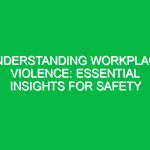Introduction
Hello team! Today, we are holding a Toolbox Talk on a crucial topic that we often encounter in our daily operations: the phrase “Not My Problem.” This mindset can be detrimental not only to our Safety culture but also to the overall efficiency of our work Environment. Our goal today is to explore how embracing responsibility can enhance our health, safety, and environment (HSE) practices. By the end of this talk, we will better understand how our actions—or inactions—can impact not just ourselves, but our colleagues and the workplace as a whole.
The Meaning of “Not My Problem” in the Workplace
The phrase “Not My Problem” signifies a lack of accountability or unwillingness to engage with issues that may not directly affect us. In an HSE context, this attitude can lead to serious ramifications. When one person dismisses a Safety concern or hazard, it can escalate into a situation that affects everyone. For instance, if you notice a spill but think, “That’s not my job,” you may unknowingly put yourself and your colleagues at risk of slipping and falling.
Real-Life Example
Consider a scenario where a worker sees a colleague working without proper Personal Protective Equipment (PPE). If their reaction is to think, “Not my problem,” they might ignore the situation. However, this not only compromises that worker’s safety but also sets a precedent for others. The worker without PPE may influence others to disregard safety protocols, creating a more dangerous environment.
The Importance of Accountability in HSE
Taking responsibility is vital for fostering a safe workplace. When everyone adopts an attitude of accountability, we create a culture where safety is prioritized. Here’s why accountability is essential:
- Prevention of Accidents: When employees feel responsible for their surroundings, they are more likely to report Hazards before they lead to accidents.
- Team Cohesion: A sense of shared responsibility promotes teamwork and cooperation, leading to a more efficient work environment.
- Compliance with Regulations: Understanding our roles in maintaining safety Standards ensures we meet legal obligations and avoid penalties.
Identifying Hazards Related to “Not My Problem”
In our work environments, various hazards can arise from the mindset of “Not My Problem.” Here are some examples:
- Physical Hazards: Ignoring spills, debris, or faulty equipment can lead to slips, trips, and falls, which are common workplace injuries.
- Health Hazards: Failing to address unsafe work practices, such as improper lifting techniques or inadequate ventilation, can lead to long-term health issues.
- Environmental Hazards: Neglecting waste disposal protocols can result in environmental contamination, which could have legal and reputational consequences for our organization.
Best Practices to Combat “Not My Problem” Mentality
To cultivate a culture of responsibility, we must actively work against the “Not My Problem” mindset. Here are some Best Practices to implement:
- Speak Up: If you see something unsafe, report it. Encourage your colleagues to do the same. Remember, safety is everyone’s responsibility.
- Lead by Example: Demonstrate accountability in your actions. If you notice a hazard, take steps to address it, or seek help if necessary.
- Provide Support: If a colleague seems overwhelmed, offer assistance rather than assuming it’s not your concern. A supportive work environment nurtures accountability.
- Engage in Training: Regular HSE training sessions can reinforce the importance of responsibility and educate employees on how to handle various hazards.
Encouraging Open Dialogue
Encouraging open communication is vital in fostering a culture of responsibility. During Toolbox Talks, ask open-ended questions to stimulate discussion about safety concerns. For example:
- What safety hazards have you observed recently?
- How can we support each other in maintaining a safe workplace?
- What steps can we take to ensure everyone feels responsible for safety?
Regulations and Standards
Understanding the legal framework surrounding Workplace Safety can also help combat the “Not My Problem” mentality. Various regulations govern Workplace Safety, including:
- Occupational Safety and Health Administration (OSHA): osha sets and enforces standards to ensure safe working conditions.
- Environmental Protection Agency (EPA): The EPA regulates Environmental Safety and waste management practices.
- Company Policies: Familiarize yourself with our organization’s specific safety protocols and policies. Compliance with these policies is not optional; it’s a requirement.
Impact of Compliance
Compliance with these regulations is essential not only for legal reasons but for fostering a safe working environment. Non-compliance can lead to severe penalties, including fines and increased scrutiny from regulatory bodies. More importantly, it can result in accidents that could have been prevented. Remember, embracing responsibility starts with understanding our obligations.
Conclusion
In conclusion, the “Not My Problem” mindset can significantly impact our Workplace Safety and culture. By cultivating a sense of responsibility among all team members, we can prevent accidents, promote a healthier work environment, and ensure compliance with safety regulations. Let’s commit today to speak up, support one another, and lead by example in our daily operations.
Thank you for your attention and for your commitment to maintaining a safe and responsible workplace. Remember, safety is not just your problem or my problem; it’s our problem. Together, we can make a difference!


